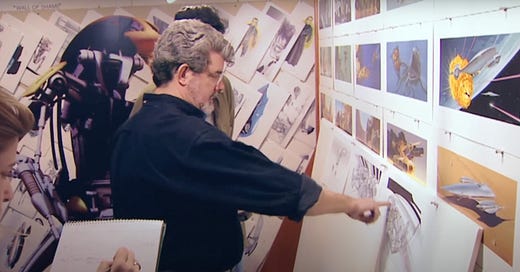George Lucas' Three-Second Rule, Explained
When it came to choose the best designs for Star Wars, George Lucas had a very specific rule in mind: the three-second rule. But what does it mean? I'm glad you asked.
Even if you’ve never seen a Star Wars film, you’ll probably be familiar with some of the iconic elements of the space saga created by George Lucas. The most striking are, of course, the lightsabers glowing in different colors and illuminating even the darkest place in the galaxy far, far away. You probably even stumbled across characters like Luke Skywalker, Princess Leia and Darth Vader who say cryptic things like “May the Force be with you” and “I am your father”.
And then, of course, there are all the unmistakable designs, from armor to spaceships. Boba Fett is the best example: before the bounty hunter was developed into a fully fleshed out character, it was primarily the design that breathed life into what would become the blueprint of the Mandalorian aesthetic with all its helms, jetpacks and flamethrowers. Podracers, gunships and starfighters: Star Wars has so many distinctive designs to offer that it's impossible to list them all.
It's all the easier for that to place these designs in the galaxy. Buildings, costumes and planet surfaces: For a cinematic universe that has been constantly expanding for almost five decades, it is absolutely remarkable how accessible Star Wars still is. Despite the increasingly complex mythology, the saga is easy to understand on a visual level – even for newcomers who have never heard of Midi-chlorians before. That's what George Lucas ensured with the three-second rule.
When you watch a film at the cinema, you can't pause it or rewind it if something is unclear. What happens on the screen has to be self-explanatory. Most things that can't be grasped in three seconds are lost in the stream of information because the next detail is already coming. Since a big blockbuster like Star Wars overwhelms you with a lot of new information, it was very important that the images were intuitively comprehensible. And this was achieved by the three-second rule.
Concept art mastermind Doug Chiang, who worked with Lucas on the prequels, remembers this process:
During one of our art meetings, I was presenting to George Lucas a bunch of designs. He came into the room and very quickly looked at the whole board and right away identified the two or three that he really liked, not the one that I liked.
He explains further:
I finally had the courage to say, “why did you pick those and not this?”, and he said, “Doug, the designs have to live by themselves, when you see them on screen, you're not going to be there to explain what it is, the audience has to connect with it right away. They have to know its personality, its function, where the pilot sits, which direction it's going, all those things in less than three seconds and if you can do that in a design without any explanation, the design will be that much more powerful.”
When Lucas was satisfied with the designs, he stamped an “OK” on the paper. When he was really impressed, he left a “Fabulouso” [sic]. And when he was unsatisfied there was an infamous stamp with the words “Deep regret”, but it was rarely used. If a design received neither “OK” nor “Fabulouso”, the answer was clear: it failed and had to be revised. Or as Lucasfilm creative art manager Phil Szostak put it:
In the time that I worked with him, George [Lucas] very kindly never used the deep regret stamp. It just sat there with the others as motivation.
Lucas' motivation proved successful: To this day, you can immediately tell whether a spaceship belongs to the good guys or the bad guys. Whether a mask hides a villain or an ally. And whether this is a planet to linger on or to run away from as fast as possible. No other franchise has such a sophisticated design language as Star Wars. And the three-second rule probably played a not inconsiderable part in this.
Image credit: Lucasfilm






I think most fans have beef with George at some level, but full-stop: that approach to machine design in cinema is plain and simple genius.
That's very interesting and not something that I had heard before. I suppose the counterpoint would be, Star wars seems to treat you like a child who cannot understand nuance. Which after enough movies in a row is pretty off-putting.